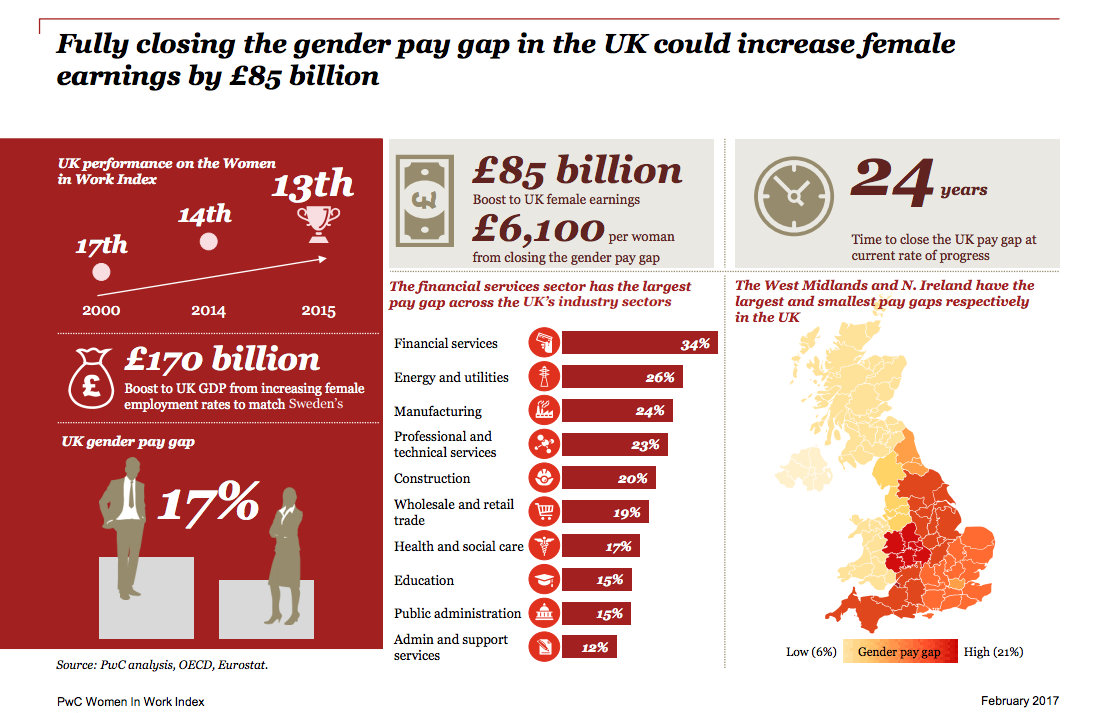The 2017 edition of the PwC Women in Work Index reveals both good news and bad news for gender parity advocates. The UK’s position in the OECD-wide study has improved from the 14th to 13th position this year, with a general wage gap at around 17 per cent. However, the authors of the report conclude that this is from the UK’s improving economic conditions, which has stimulated employment for both genders.
The staggering fact remains that the financial service sector has the largest pay gap among all verticals in the UK, at 34 per cent.

Transparency in reporting is the first step
According to PwC executive board member and head of people, Laura Hinton, the current rate of progress towards closing the gender pay gap is too slow, but gender pay gap reporting is an important step towards tackling both the symptoms and causes of gender inequality in the workplace. “Publishing pay data alone won’t change anything – progress will only happen if organisations use this as an opportunity to understand what’s happening in their business and make some fundamental changes as a result. Bold action is needed to create true equality in the workplace. For the first time, we will have comparable gender pay gap figures across organisations which will be a useful tool to drive accountability and action,” she explains.
“At PwC, publishing our gender pay gap has allowed us to understand the reasons for the gap and hold ourselves accountable to make changes. For example, we know that a sizeable part of our pay gap is a result of having fewer women in senior positions, so this is an area where we continue to focus our efforts. We’re also challenging our recruitment processes, making more senior jobs available on a flexible or part-time basis, and have introduced a return to work programme.”
“In our experience there is no silver bullet and the gender pay gap is just one data point that organisations should be tracking as part of their overall efforts to create a workplace that works for all.”
Industry events may be a stepping stone
For many women in senior roles within financial services, industry events, from networking and mentoring groups to awards like the HM Treasury-backed Women in Finance Awards, are a starting point in a long journey.
In order to increase diversity within the industry, the concept of different needs to be normalised.
Awards events provide industry recognition, and highlights the work of talented individuals outside the office environment, which both raises the profile of women in finance, as well as connecting like-minded people advocating diversity in the industry. For sectors like financial services, where many women tend to stagnate around the mid-career level, industry events can provide a career-catapult to help them push through the glass ceiling.
Keeping tabs on the gender pay gap
The government and the Office for National Statistics created an online tool specifically to calculate the gender pay gap across industries and job levels. The online tool uses the latest data from the Annual Survey of Hours and Earnings to provide the most up to date gender pay gap data. The gender pay gap is now at a record low of 18.1 per cent and the online tool will show the gender pay gap by profession, so that the public can see how their job measures up against the national average.
Alongside the tool, an online quiz has also been launched allowing people to challenge their knowledge of what the gender pay gap is for a variety of professions.
As of December 2016, it reveals that construction and building trades, and financial managers and directors have the highest gender pay gaps in the UK.
“Britain has the lowest gender pay gap on record, there are more women in work than ever before, more women-led businesses than ever before and there are now women on every board in the FTSE 100,” says Minister for Women and Equalities Justine Greening, glossing over the fact that even though there have been general improvements, the gap still exists. And it may take the UK 13 years to close the gap, taking the business as usual scenario.
What is the gender pay gap?
The gender pay gap is an equality measure that shows the difference in average earnings between women and men. At 18.1 per cent, the gender pay gap for all employees is the lowest since records began in 1997. The gender pay gap does not show differences in pay for comparable jobs. Unequal pay for men and women has been illegal for 45 years.
What are some of the targets for the government?
As well as requiring large employers to publish their gender pay and gender bonus pay gaps, to help drive further progress and eliminate the gender pay gap in a generation the government is:
- Working with business to have 33 per cent of women on boards by 2020 and eliminate all-male boards in the FTSE 350; and
- Doubling the amount of free childcare available to working parents of three and four year olds, helping to remove the barriers that can prevent women from returning to the workplace.
This builds on the changes government has already introduced to support women in the workplace, including:
- Extending the right to request flexible working to all employees;
- Introducing a new system of flexible parental leave;
- Supporting women’s enterprise by helping female entrepreneurs start up and grow their own business; and
- Increasing the National Living Wage, of which two-thirds of recipients are women.
The regulations, which will affect almost 8,000 employers with around 11 million employees, will shine a light on workplace practices that could be preventing women from reaching the top in their organisations. Tackling injustices like the fact that women earn on average less than men is a key part of building a society and country that works for everyone, as Theresa May made clear in her first speech as Prime Minister.
The government’s drive for gender pay gap reporting now requires employers in the private and voluntary sectors to:
- Publish their median gender pay gap figures
By identifying the wage of the middle earner, the median is the best representation of the ‘typical’ gender difference. Employers will be asked to use data from a ‘snapshot’ period in April to calculate this average.
- Publish their mean gender pay gap figures
By taking into account the full earnings distribution, the mean look at both the low and high earners in an organisation – this is particularly useful as women are often over-represented at the low earning extreme and men are over-represented at the high earning extreme. As with the median gender pay gap, employers will use data from a ‘snapshot’ period in April.
- Publish the proportion of men and women in each quartile of the pay structure.
This data will show the spread of male and female earners across an organisation, helping to show employers where women’s progress might be stalling so they can take action to support their career development.
- Publish the gender pay gaps for any bonuses paid out during the year
As there is a significant issue around bonus payments in some sectors, employers will also have to publish the proportion of male and proportion of female employees that received a bonus during the year.
What will happen following the publishing of these regulations?
Government will be working with employers to prepare for April 2017 and providing guidance to support them. It will also be looking to publish regulations for public sector employers “in due course”, according to a statement.
What do businesses think?
Key responses from employers and business organisations to the first consultation revealed that 82 per cent of businesses believe transparency will encourage employers to take action to close the gender pay gap, and 50 per cent agreed that the threshold of 250 employees was appropriate. Already, 68 per cent of organisations who are in scope of the regulations state they can currently calculate an overall GPG figure, while 63 per cent of organisations agreed that civil enforcement procedures would help ensure compliance.
Too little, too slow?
The Women and Equalities Committee raised concerns today that the government is not effectively tackling the structural cause of the gender pay gap. The Committee’s report was published in March 2016 and it received a government response in January 2017, which generally rejected many of the recommendations. While the UK government recognises the socioeconomic benefits of helping women to unlock their talents, to the tune of £150 billion more to our annual GDP by 2025, today’s news suggests that there is still a long way to go before the gender pay and promotion gap can be bridged through nationwide legislation.
The Women and Equalities Committee’s recommendations include:
- Addressing the part-time pay penalty and flexible working
Flexible working for all lies at the heart of addressing the gender pay gap. This does not mean part-time working, which is underpaid and limits career progression. The government is not taking the steps needed to ensure flexible working is offered to all employees, particularly those in lower paid sectors, the report found.
- Supporting parents to share childcare equally
According to the report, as long as women continue to take the majority of responsibility for childcare and other forms of unpaid caring, pay differentials will persist. The government recognises the benefits of men and women sharing care equally, but its flagship policy, shared parental leave – is predicted to make little difference to behaviour.
- Supporting women back into the workforce after time out of the labour market
The inquiry also found that women faced a number of barriers to returning to work and that there is more scope for schemes which support women returning to work across a range of occupations.
- Addressing low pay in highly feminised sectors such as catering, cleaning and caring
Other than the minimum wage, there has been no co-ordinated attempt to address the issues faced by women in low paid sectors.
The Committee is also launching a web forum for stakeholders, including researchers, business-people and members of the public, to respond to the reasons given by the government for not implementing the Committee’s recommendations.
Blanket rejection
The government’s response recognises the business case for reducing the gender pay gap and notes that, while the rate of female participation in the labour market has increased, “unfair or distorting barriers to work” remain. It acknowledges structural factors contributing to the pay gap, including women doing jobs for which they are overqualified, concentration in part-time work, and being penalised for taking time out of work to raise children.
Despite this, the government rejected most of the Committee’s seventeen evidence-based recommendations for addressing these issues. It highlights gender pay gap reporting, as “key to accelerating progress,” and maintains that current policies on shared parental leave, flexible working, and supporting women back into work are adequate, despite research showing otherwise.
The Committee will continue to pursue government action
According to the Committee’s chair Maria Miller, the group has no intention of giving up its efforts. “The government says there is no place for a gender pay gap in modern Britain and has restated its pledge to end the pay gap within a generation. But without effectively tackling the key issues of flexible working, sharing unpaid caring responsibilities, and supporting women aged over 40 back into the workforce, the gender pay gap will not be eliminated,” she explains. “We made practical, evidence-based recommendations to address these issues. They were widely supported by a range of stakeholders including businesses, academics, and unions. It is deeply disappointing that our recommendations have not been taken on board by government. My Committee will continue to pursue urgent action to reduce the gender pay gap.” She says the Committee will start by questioning the Secretary of State for Women and Equalities, Justine Greening MP, on this “inadequate response” on Wednesday 26 April.
Government response lacks evidence
The Committee is calling for evidence on the responses made by the government to the following three recommendations made in the Committee’s report:
All jobs should be available to work flexibly unless an employer can demonstrate an immediate and continuing business case against doing so.
The latest data from 2016 shows that just 8.7 per cent of jobs paying a full-time equivalent of £20,000 are advertised as available to work flexibly or part-time. The committee report demonstrated that this creates a significant bottleneck to women’s employment, promotion and progression opportunities. The government response argued that the right to request flexible working which is in place now “strikes a balance between giving employees the flexibility to combine work with other responsibilities and allowing employers to plan effectively. Employers can also advertise jobs on flexible terms or offer flexible working arrangements to their employees outside the statutory scheme if they wish – and many employers already do so.” But tangible evidence remains to be seen.
A more effective policy on shared parental leave.
The Committee recommended that fathers and second parents should be entitled to three months’ well-paid, non-transferrable paternal leave in addition to current parental leave benefits. The committee also recommended equalising the payments for the first four weeks of maternity and paternity pay. The government rejected these proposals for reforming parental leave on the grounds that shared parental leave is “still a very new policy”; it also pointed to the additional cost of well-paid paternity leave and argued that the proposals would offer less flexibility.
A national ‘Pathways into Work’ scheme for harnessing the skills and experience of women over 40.
This scheme would give women a clear entry point into a support system offering careers guidance; retraining where necessary; and information on local skills shortages and job opportunities. The government rejected this recommendation on the grounds that it “already provides advice and support to help women over 40 through the National Careers Service.” It also pointed to evidence for its Advanced Learner Loans, Mid-Life Career Review, and work experience and training programmes for benefit claimants aged 45 or older.
According to Alison Dodd, managing director at Moorepay, today’s news that the government is rejecting recommendations for addressing the gender pay gap is a “shame”.
“While current polices such as shared parental leave, flexible working and measures to support women coming back to work are all welcome, more must be done to fight the root causes of the UK gender pay gap. However, the onus is not just on the government to introduce such measures,” she says. “UK businesses also need to ensure they are putting equal, fair and transparent pay and benefit schemes in place to rid the country of gender inequality once and for all. Only when businesses actively promote true equality can we start to make steps to completely eradicate the gender pay gap.”
For NGA Human Resources‘ Geoff Pearce, businesses need to act responsibly and inclusively, regardless of government legislation. “Companies shouldn’t need to wait for legislation before they take any action. Organisations need to continually monitor their internal policies to ensure they promote fairness and equality if the gap is to close for good,” he says. “Policies like shared parental leave and flexible working will not just reduce the gender pay divide, but also boost engagement, productivity and profitability, which benefits both the company and its employees. Only when the government and the private sector collectively promote true equality will the UK gender pay gap significantly reduce.”
https://growthbusiness.co.uk/gender-pay-gap-2548432/








